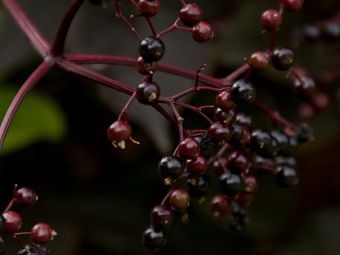
Visit the Vermont Garden Journal
Become a Fan on Facebook
Jellies, syrups, and tonics are some healthful and delicious ways to enjoy the fruits of the elderberry bush. Charlie discusses the finer points of choosing, planting, and caring for the elderberry variety that is right for you. Tune in Friday evening and Saturday morning for elderberry myths and cultivation methods.
I’m Charlie Nardozzi and this is the
Vermont Garden Journal. One of my favorite mid summer flowering shrubs is the
elderberry. It’s easy to grow, widely adapted, beautiful to look at, and
produces tasty, healthful berries. It can also tolerate wet soils and still
grow and produce well. That’s a plus with our spring and early summer weather
this year.
Elderberries are hardy to zone 3,
so even gardeners in the far reaches of the Northeast Kingdom can grow them.
While just collecting berries from wild shrubs growing in abandoned fields and
meadows is fine, growing specific varieties for beauty or berry production is
better. If you’re interested in berries, look for varieties such as ‘York’ and
‘Nova’ which produce large clusters and sized berries that are easy to harvest
and process. If you’re growing them for an edible landscape shrub, try the
purple-foliaged colored ‘Black Beauty’ or ‘Black Lace’ varieties. I
particularly like ‘Black Lace’, because the leaves look like a Japanese maple
tree.
Plant shrubs 4 to 6 feet apart in
full to part sun and preferably in well drained moist soil. The key with
keeping them looking and producing well is pruning. Remove any dead, diseased
or damaged branches in spring. Any branches older than 3 years should also be
removed to encourage new growth. Elderberries produce the most flowers and
berries on 1 and 2 year old shoots. To keep the birds away, use netting over
the bushes.
Harvest the white, flat flowers to
make wine, champagne or to float as a relaxant in a hot bath. Use the berries
to make juice, wine, or jam. Elderberry juice also makes a great winter tonic
syrup. My friend Stephen mixes elderberry syrup, apple cider vinegar, and raw
honey together for a tonic he swears keeps his family healthy all winter.
Now for this week’s tip, sprinkle a
cup of dried coffee grounds around blueberries and roses to promote greener
leaves and stronger growth.
Next week on
the Vermont Garden Journal, I’ll be talking about exotic insect pests. For now,
I’ll be seeing you in the garden!